Prefabricated Ferrocement Jacket for Repairing and Strengthening Axially Loaded Square Sub-Standard Concrete Stub Columns
Abstract
:1. Introduction
Novelty of This Research
2. Methodology
2.1. Materials
2.2. Concrete and Grout Mix Design
2.3. Preparation of Concrete Specimen
2.4. Preparation of Precast Ferrocement Jackets (PFJ)
2.5. Jacketing of Column Specimens with Precast Ferrocement Jackets (PFJ)
2.6. Testing Procedure of Specimen
3. Results and Discussion
3.1. Load Bearing Capacity
3.2. Axial and Lateral Deflections
3.3. Stress and Strain Response
3.4. Failure Behaviour
4. Conclusions
- i.
- Wearable prefabricated ferrocement jackets improve the load-bearing capacity, ultimate axial deflection, and lateral deflection of the columns, in comparison with non-jacketed specimens. U-shaped PFJ is more effective than L-shaped PFJ in repairing and strengthening square columns.
- ii.
- More cracks are observed at the connection joint between the precast ferrocement jackets, which is due to the poor bearing capacity of the steel spokes used to connect two jackets for confinement. However, no cracks were observed at the corner of either L-shaped or U-shaped jackets due to the extra layer of wire mesh at the corners.
- iii.
- Based on the failure pattern, it can be said that both types of jackets are effective in controlling the failure of core specimens. However, further study on the jointing mechanism is required to ascertain an efficient wearable PFJ technique.
Author Contributions
Funding
Institutional Review Board Statement
Informed Consent Statement
Data Availability Statement
Acknowledgments
Conflicts of Interest
Abbreviations
| FRCC | Fibre-Reinforced Cementitious Composite |
| ECC | Engineered Cementitious Composite |
| FRP | Fibre-Reinforced Polymer |
| PFJ | Prefabricated Ferrocement Jackets |
| OPC | Ordinary Portland Cement |
| LVDT | Linear Variable Displacement Transducers |
| CS | Control Sample |
| PCSLPFJ | Pre-cracked Specimen with L-shaped Prefabricated Ferrocement Jackets |
| PCSUPFJ | Pre-cracked Cracked Specimen with U-shaped Prefabricated Ferrocement Jackets |
| UCSLPFJ | Un-cracked Specimen with L-shaped Prefabricated Ferrocement Jackets |
| UCSUPFJ | Un-cracked Specimen with U-shaped Prefabricated Ferrocement Jackets |
References
- Kai, B.; Kaish, A.B.M.A.; Nordin, N. Concrete-Filled Prefabricated Cementitious Composite Tube (CFPCCT) under Axial Compression: Effect of Tube Wall Thickness. Materials 2022, 15, 8119. [Google Scholar] [CrossRef] [PubMed]
- Modoni, G.; Bzówka, J. Analysis of foundations reinforced with jet grouting. J. Geotech. Geoenvironmental. Eng. 2012, 138, 1442–1454. [Google Scholar] [CrossRef]
- Kaish, A.B.M.A.; Alam, M.R.; Jamil, M.; Zain, M.F.M.; Wahed, M.A. Improved ferrocement jacketing for restrengthening of square RC short column. Constr. Build. Mater. 2012, 36, 228–237. [Google Scholar] [CrossRef]
- Kaish, A.A.; Alam, M.R.; Jamil, M.; Wahed, M.A. Ferrocement jacketing for restrengthening of square reinforced concrete column under concentric compressive load. Procedia Eng. 2013, 54, 720–728. [Google Scholar] [CrossRef]
- Lin, G.; Zeng, J.J.; Teng, J.G.; Li, L.J. Behavior of large-scale FRP-confined rectangular RC columns under eccentric compression. Eng. Struct. 2020, 216, 110759. [Google Scholar] [CrossRef]
- Ruan, Y.; Zhang, W.; Wang, J.; Wang, D.; Yu, X.; Han, B. Nanocarbon material-filled cementitious composites for construction applications. In Nanocarbon and Its Composites; Woodhead Publishing: Sawston, UK, 2019; pp. 781–803. [Google Scholar]
- Lo Monte, F.; Ferrara, L. Tensile behaviour identification in Ultra-High Performance Fibre Reinforced Cementitious Composites: Indirect tension tests and back analysis of flexural test results. Mater. Struct. 2020, 53, 1–12. [Google Scholar] [CrossRef]
- Raza, S.; Khan, M.K.; Menegon, S.J.; Tsang, H.H.; Wilson, J.L. Strengthening and repair of reinforced concrete columns by jacketing: State-of-the-art review. Sustainability 2019, 11, 3208. [Google Scholar] [CrossRef]
- Kazemi, M.T.; Morshed, R. Seismic shear strengthening of R/C columns with ferrocement jacket. Cem. Concr. Compos. 2005, 27, 834–842. [Google Scholar] [CrossRef]
- Minde, P.; Bhagat, D.; Patil, M.; Kulkarni, M. A state-of-the-art review of ferrocement as a sustainable construction material in the Indian context. Mater. Today Proc. 2023. [Google Scholar] [CrossRef]
- Kaish, A.B.M.A.; Jamil, M.; Raman, S.N.; Zain, M.F.M. Axial behavior of ferrocement confined cylindrical concrete specimens with different sizes. Constr. Build. Mater. 2015, 78, 50–59. [Google Scholar] [CrossRef]
- Cao, X.M.; Xiao, J.C.; Huang, Z.H. Experimental research on regional confined concrete columns under compression. In Proceedings of the Challenges, Opportunities and Solutions in Structural Engineering and Construction, Melbourne, Australia, 7–10 December 2010; pp. 479–484. [Google Scholar]
- Kaish, A.B.M.A.; Nahar, L.; Jaafar, A.; Ahmed, Y. Prospects of using Prefabricated Ferrocement Jacket for Semi-Automated Strengthening of RC Column. Electron. J. Struct. Eng. 2018, 18, 2. [Google Scholar]
- Xiao, Y.; Ma, R. Seismic retrofit of RC circular columns using prefabricated composite jacketing. J. Struct. Eng. 1997, 123, 1357–1364. [Google Scholar] [CrossRef]
- Gao, S.; Jin, R.; Lu, W. Design for manufacture and assembly in construction: A review. Build. Res. Inf. 2020, 48, 538–550. [Google Scholar] [CrossRef]
- Uomoto, T.; Mutsuyoshi, H.; Katsuki, F.; Misra, S. Use of fiber reinforced polymer composites as reinforcing material for concrete. J. Mater. Civ. Eng. 2002, 14, 191–209. [Google Scholar] [CrossRef]
- Haq, M.; Bhalla, S.; Naqvi, T. Fatigue damage and residual fatigue life assessment in reinforced concrete frames using PZT-impedance transducers. Cem. Concr. Compos. 2020, 114, 103771. [Google Scholar] [CrossRef]
- Tzoura, E.A.; Triantafillou, T.C.; Providakis, C.; Tsantilis, A.; Papanicolaou, C.G.; Karabalis, D. Damage detection of reinforced concrete columns retrofitted with FRP jackets by using PZT sensors. Struct. Monit. Maint 2015, 2, 165–180. [Google Scholar] [CrossRef]
- Nepomuceno, E.; Sena-Cruz, J.; Correia, L.; D’Antino, T. Review on the bond behavior and durability of FRP bars to concrete. Constr. Build. Mater. 2021, 287, 123042. [Google Scholar] [CrossRef]
- Faleschini, F.; Zanini, M.A.; Hofer, L.; Pellegrino, C. Experimental behavior of reinforced concrete columns confined with carbon-FRCM composites. Constr. Build. Mater. 2020, 243, 118296. [Google Scholar] [CrossRef]
- Moussa, O.; Vassilopoulos, A.P.; de Castro, J.; Keller, T. Early-age tensile properties of structural epoxy adhesives subjected to low-temperature curing. Int. J. Adhes. Adhes. 2012, 35, 9–16. [Google Scholar] [CrossRef]
- Wang, Y.S.; Peng, K.D.; Alrefaei, Y.; Dai, J.G. The bond between geopolymer repair mortars and OPC concrete substrate: Strength and microscopic interactions. Cem. Concr. Compos. 2021, 119, 103991. [Google Scholar] [CrossRef]
- Mohammed, A.A.; Manalo, A.C.; Ferdous, W.; Zhuge, Y.; Vijay, P.V.; Alkinani, A.Q.; Fam, A. State-of-the-art of prefabricated FRP composite jackets for structural repair. Eng. Sci. Technol. Int. J. 2020, 23, 1244–1258. [Google Scholar] [CrossRef]
- Nathan, G.K. Mechanical properties of ferrocement materials. In Proceedings of the First Australian Conference on Engineering Materials, Sydney, Australia; 1974; pp. 309–332. [Google Scholar]
- Kaushik, S.K.; Trikha, D.N.; Kotdawala, R.R.; Sharma, P.C. Prefabricated ferrocement ribbed elements for low-cost housing. J. Ferrocem. 1984, 14, 347–364. [Google Scholar]
- Naaman, A.E.; Hammoud, H. Ferrocement prefabricated housing: The next generation. J. Ferrocem. 1992, 22, 35–47. [Google Scholar]
- Akiyama, M.; Frangopol, D.M.; Ishibashi, H. Toward life-cycle reliability risk and resilience based design and assessment of bridges and bridge networks under independent and interacting hazards: Emphasis on earthquake, tsunami and corrosion. Struct. Infrastruct. Eng. 2020, 16, 26–50. [Google Scholar] [CrossRef]
- Rajput, A.S.; Sharma, U.K. Corroded reinforced concrete columns under simulated seismic loading. Eng. Struct. 2018, 171, 453–463. [Google Scholar] [CrossRef]
- Shannag, M.J.; Barakat, S.; Jaber, F. Structural repair of shear-deficient reinforced concrete beams using SIFCON. Mag. Concr. Res. 2001, 53, 391–403. [Google Scholar] [CrossRef]
- Kondraivendhan, B.; Pradhan, B. Effect of ferrocement confinement on behavior of concrete. Constr. Build. Mater. 2009, 23, 1218–1222. [Google Scholar] [CrossRef]
- Guo, B.; Lin, X.; Wu, Y.; Zhang, L. Evaluation of flexural resistance of compression yielded concrete beams reinforced with fibre reinforced polymers. Eng. Struct. 2022, 250, 113416. [Google Scholar] [CrossRef]
- Gupta, P.K.; Sarda, S.M.; Kumar, M.S. Experimental and computational study of concrete filled steel tubular columns under axial loads. J. Constr. Steel Res. 2007, 63, 182–193. [Google Scholar] [CrossRef]
- Ma, Y.; Che, Y.; Gong, J. Behavior of corrosion damaged circular reinforced concrete columns under cyclic loading. Constr. Build. Mater. 2012, 29, 548–556. [Google Scholar] [CrossRef]
- Feng, P.; Lu, X.Z.; Ye, L.P. Experimental research and finite element analysis of square concrete columns confined by FRP sheets under uniaxial compression. In Proceedings of the 17th Australasian Conference on the Mechanics of Structures and Materials, Queensland, Australia, 12–14 June 2002; pp. 71–76. [Google Scholar]
- Kaish, A.B.M.A.; Jamil, M.; Raman, S.N.; Zain, M.F.M.; Alam, M.R. An approach to improve conventional square ferrocement jacket for strengthening application of short square RC column. Mater. Struct. 2016, 49, 1025–1037. [Google Scholar] [CrossRef]
- Sheikh, S.A.; Uzumeri, S.M. Strength and ductility of tied concrete columns. J. Struct. Div. 1980, 106, 1079–1102. [Google Scholar] [CrossRef]
- Yang, J.; Lu, S.; Wang, J.; Wang, Z. Behavior of CFRP partially wrapped square seawater sea-sand concrete columns under axial compression. Eng. Struct. 2020, 222, 111119. [Google Scholar] [CrossRef]

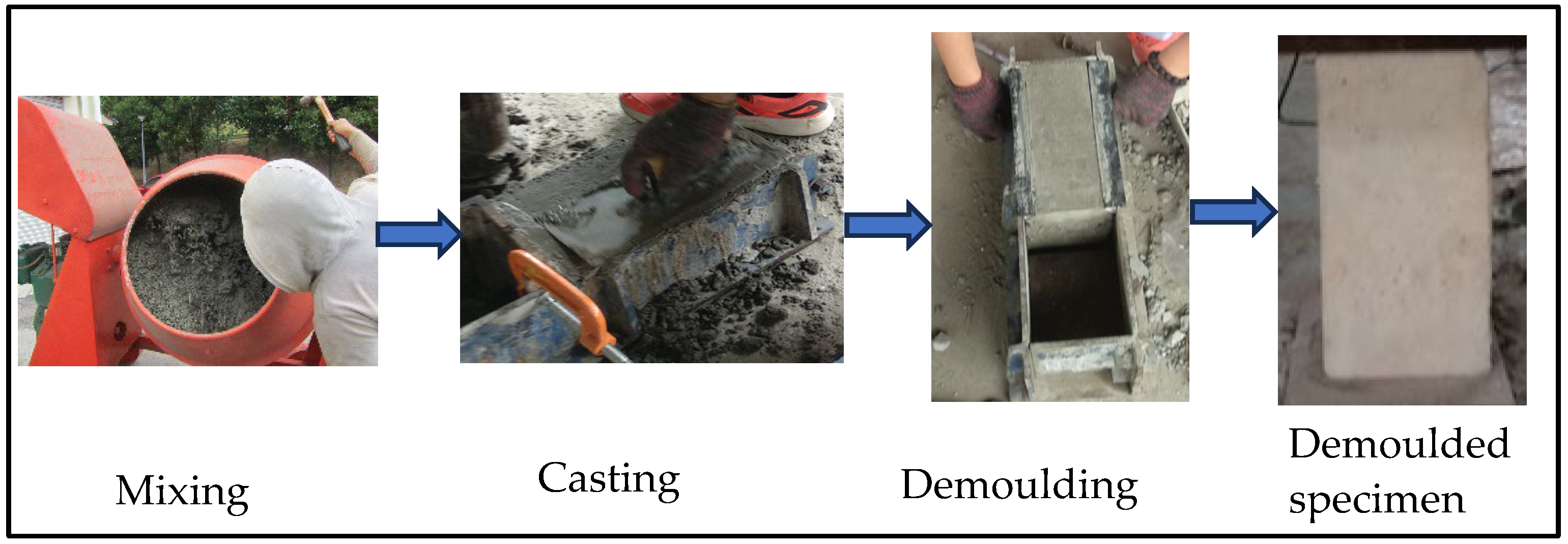
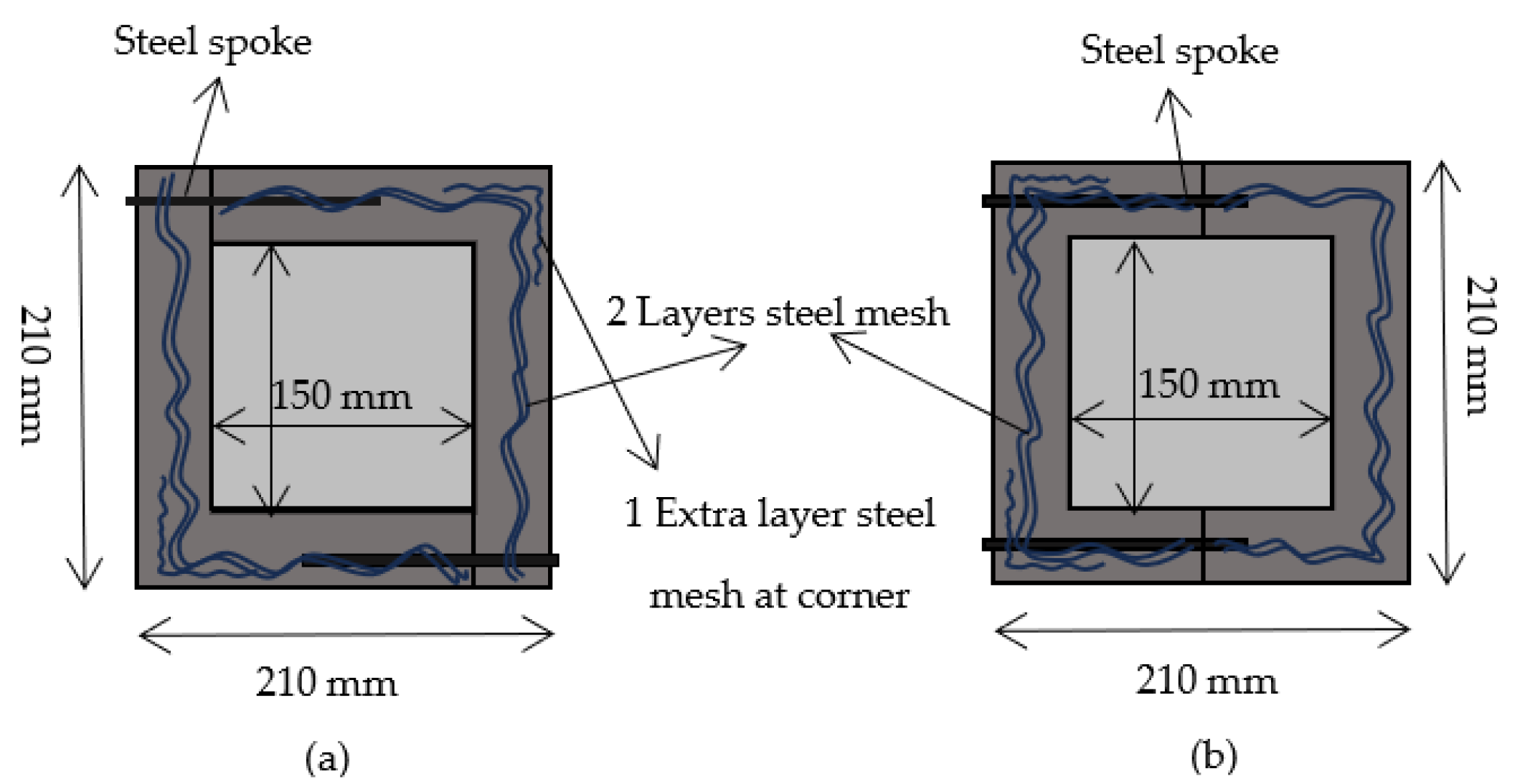
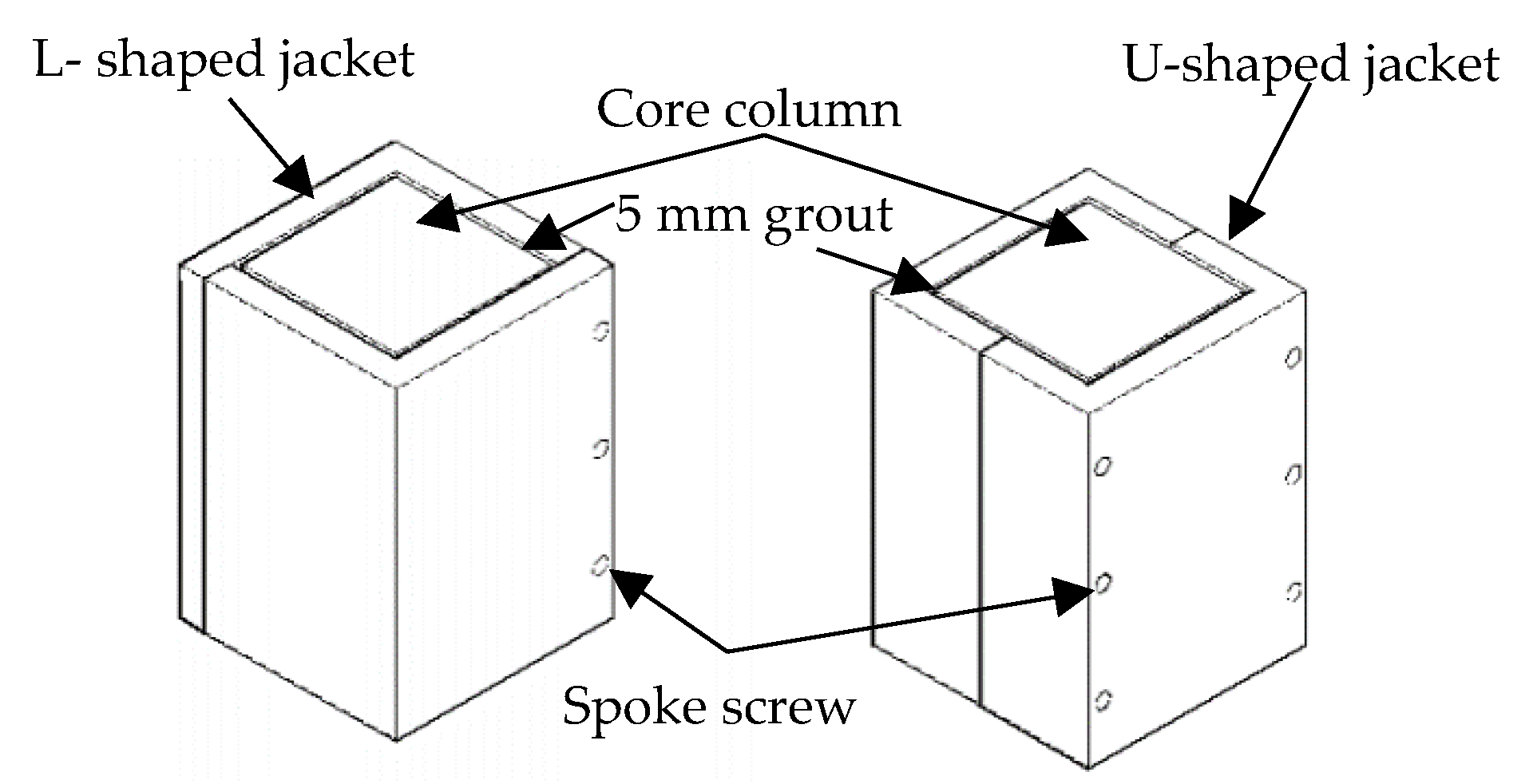
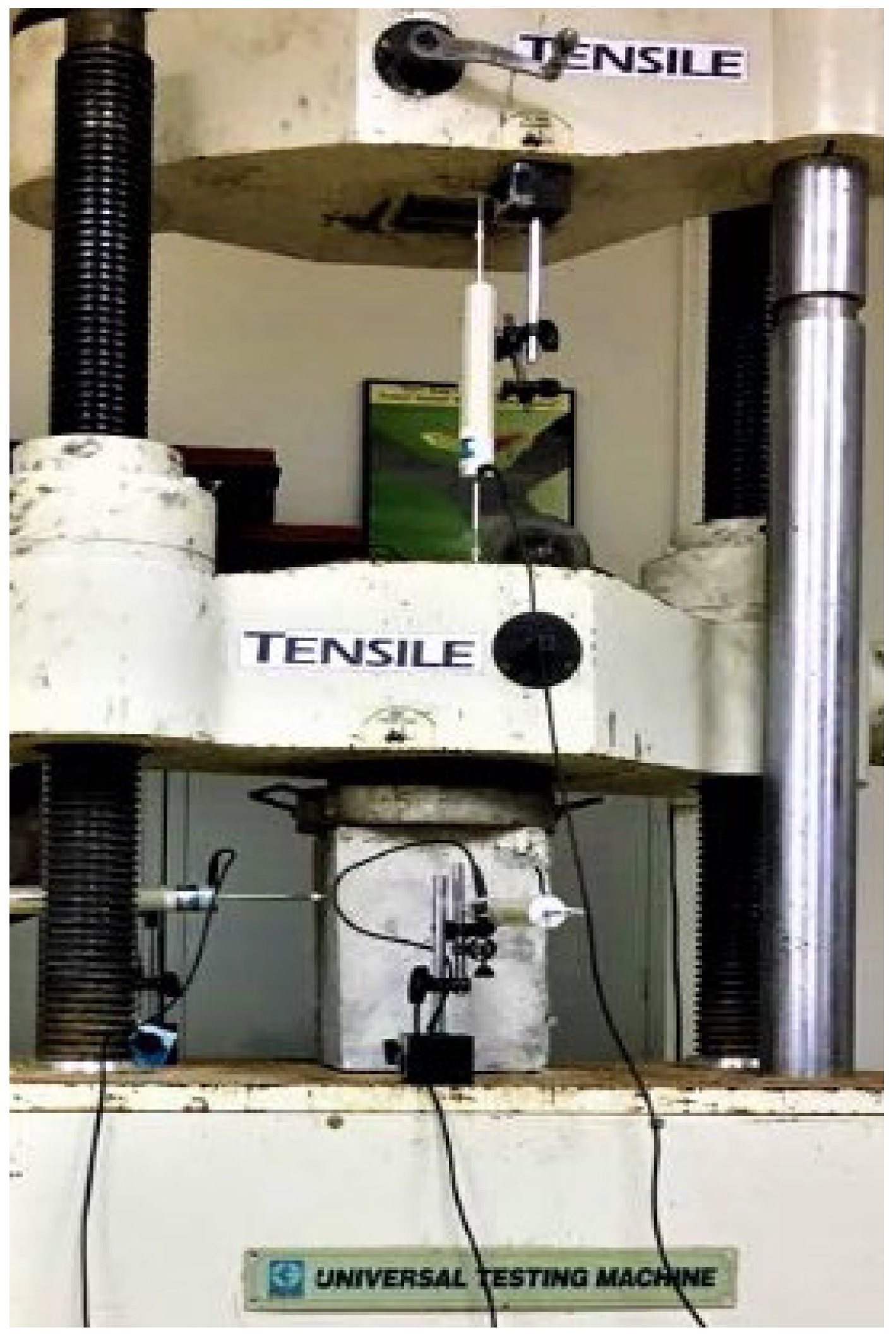
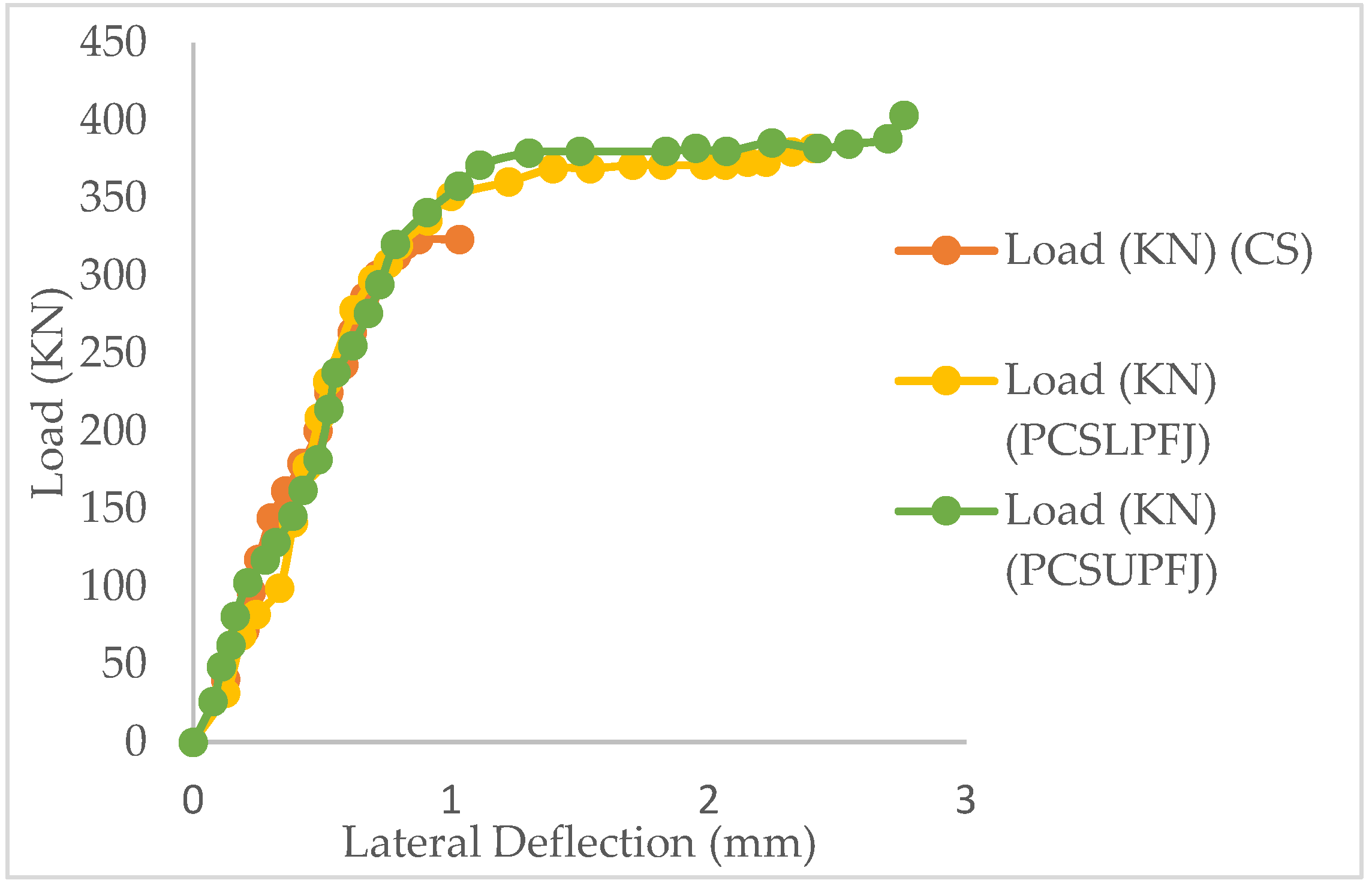


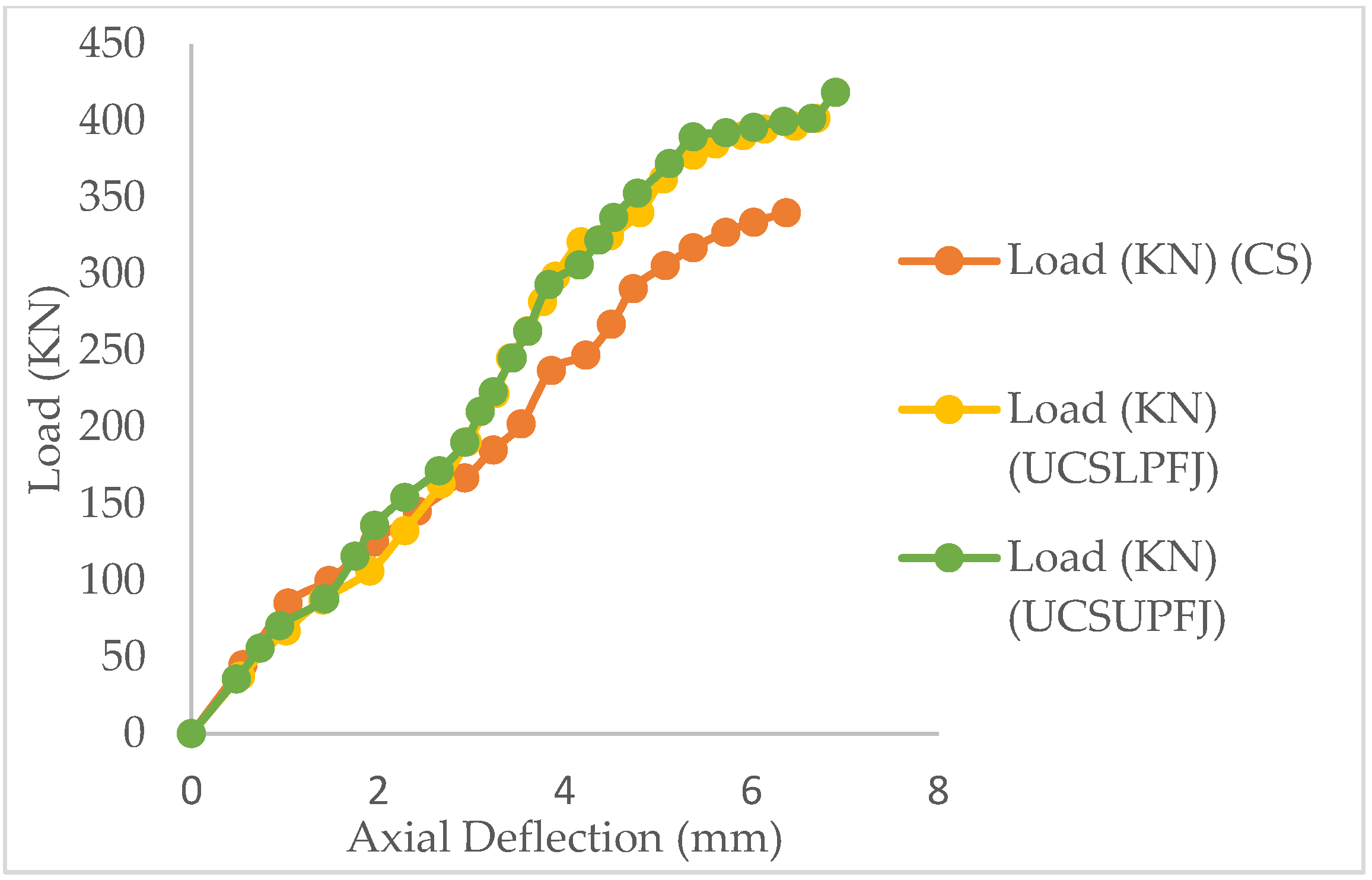

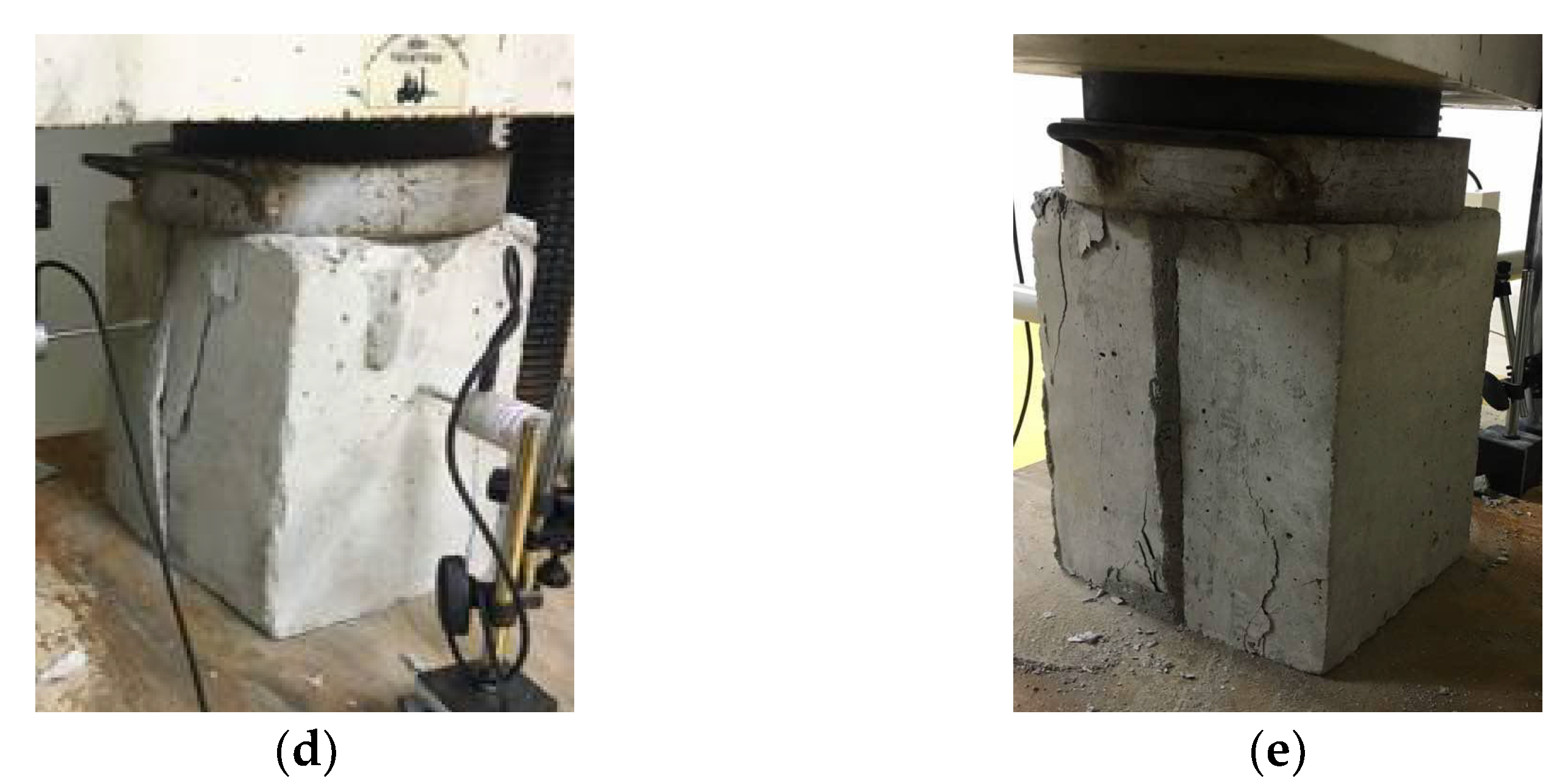
| Material | Quantity (kg/m3) |
|---|---|
| Cement | 240 |
| Water | 120 |
| Fine aggregate | 804 |
| Coarse aggregate | 906 |
| Description of Precast Square Ferrocement Jackets (PFJ) | Thickness (mm) |
|---|---|
| Four (L-Shape) precast ferrocement jackets with corners confined using two layers of wire mesh to minimise cracks. | 25 |
| Four (U-Shape) precast ferrocement jackets with middle joints confined using two layers of wire mesh to minimise cracks. | 25 |
| Specimen Type | Area (mm2) | Yield Load (kN) | Increment in Yield Load (%) | Ultimate Load (kN) | Increment in Ultimate Load (%) |
|---|---|---|---|---|---|
| Control Sample (CS) | 22,500 | 85 | - | 340 | - |
| Pre-cracked Specimen with L-shaped PFJ (PCSLPFJ) | 22,500 | 95.2 | 12 | 382z.1 | 13 |
| Pre-cracked Cracked Specimen with U-shaped PFJ (PCSUPFJ) | 22,500 | 101.5 | 19 | 403.5 | 19 |
| Un-cracked Specimen with L-shaped PFJ (UCSLPFJ) | 22,500 | 106 | 25 | 401.5 | 18 |
| Un-cracked Specimen with U-shaped PFJ (UCSUPFJ) | 22,500 | 135 | 59 | 418.7 | 23 |
| Specimen Type | Area (mm2) | Ultimate Axial Deflection (mm) | Increment in Ultimate Axial Deflection (%) | Ultimate Lateral Deflection (mm) | Increment in Ultimate Lateral Deflection (%) |
|---|---|---|---|---|---|
| Control Sample (CS) | 22,500 | 6.3 | - | 1.85 | - |
| Pre-cracked Specimen with L-shaped PFJ (PCSLPFJ) | 22,500 | 7.8 | 24 | 2.5 | 35 |
| Pre-cracked Specimen with U-shaped PFJ (PCSUPFJ) | 22,500 | 9.9 | 57 | 2.8 | 51 |
| Un-cracked Specimen with L-shaped PFJ (UCSLPFJ) | 22,500 | 6.6 | 5 | 2.1 | 14 |
| Un-cracked Specimen with U-shaped PFJ (UCSUPFJ) | 22,500 | 6.9 | 10 | 2.2 | 19 |
| Specimen Type | Ultimate Stress (mPa) | Increment in Ultimate Stress% | Ultimate Strain | Ductility |
|---|---|---|---|---|
| Control Sample | 15 | - | 0.0063 | 2.3 |
| Pre-cracked Specimen with L-shaped PFJ | 17 | 13 | 0.0078 | 3.5 |
| Pre-cracked Specimen with U-shaped PFJ | 18 | 20 | 0.0099 | 4.6 |
| Specimen with L-shaped PFJ | 18 | 20 | 0.0066 | 2.7 |
| Specimen with U-shaped PFJ | 19 | 26 | 0.0069 | 3.0 |
Disclaimer/Publisher’s Note: The statements, opinions and data contained in all publications are solely those of the individual author(s) and contributor(s) and not of MDPI and/or the editor(s). MDPI and/or the editor(s) disclaim responsibility for any injury to people or property resulting from any ideas, methods, instructions or products referred to in the content. |
© 2023 by the authors. Licensee MDPI, Basel, Switzerland. This article is an open access article distributed under the terms and conditions of the Creative Commons Attribution (CC BY) license (https://creativecommons.org/licenses/by/4.0/).
Share and Cite
Mahmood, A.; Kaish, A.B.M.A.; Mohammed Ali, T.K.; Al Zand, A.W.; Jamil, M.; Hamid, R. Prefabricated Ferrocement Jacket for Repairing and Strengthening Axially Loaded Square Sub-Standard Concrete Stub Columns. Buildings 2023, 13, 2484. https://doi.org/10.3390/buildings13102484
Mahmood A, Kaish ABMA, Mohammed Ali TK, Al Zand AW, Jamil M, Hamid R. Prefabricated Ferrocement Jacket for Repairing and Strengthening Axially Loaded Square Sub-Standard Concrete Stub Columns. Buildings. 2023; 13(10):2484. https://doi.org/10.3390/buildings13102484
Chicago/Turabian StyleMahmood, Abir, A. B. M. A. Kaish, Taghreed Khaleefa Mohammed Ali, Ahmed W. Al Zand, Maslina Jamil, and Roszilah Hamid. 2023. "Prefabricated Ferrocement Jacket for Repairing and Strengthening Axially Loaded Square Sub-Standard Concrete Stub Columns" Buildings 13, no. 10: 2484. https://doi.org/10.3390/buildings13102484
APA StyleMahmood, A., Kaish, A. B. M. A., Mohammed Ali, T. K., Al Zand, A. W., Jamil, M., & Hamid, R. (2023). Prefabricated Ferrocement Jacket for Repairing and Strengthening Axially Loaded Square Sub-Standard Concrete Stub Columns. Buildings, 13(10), 2484. https://doi.org/10.3390/buildings13102484







